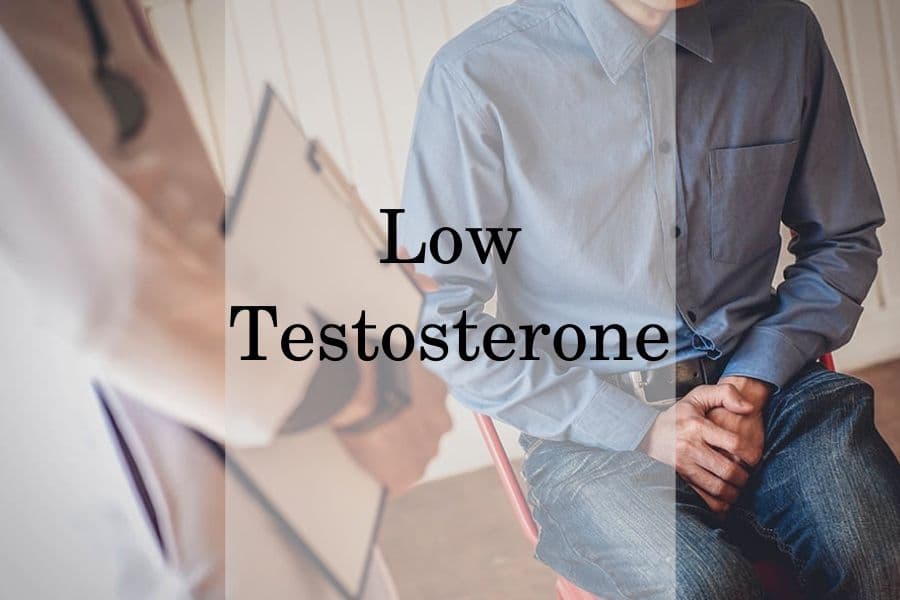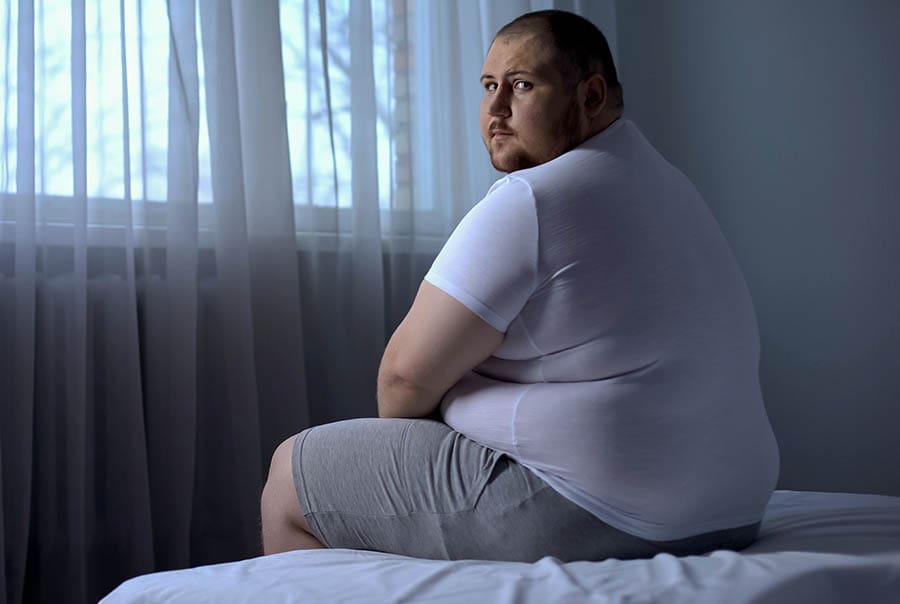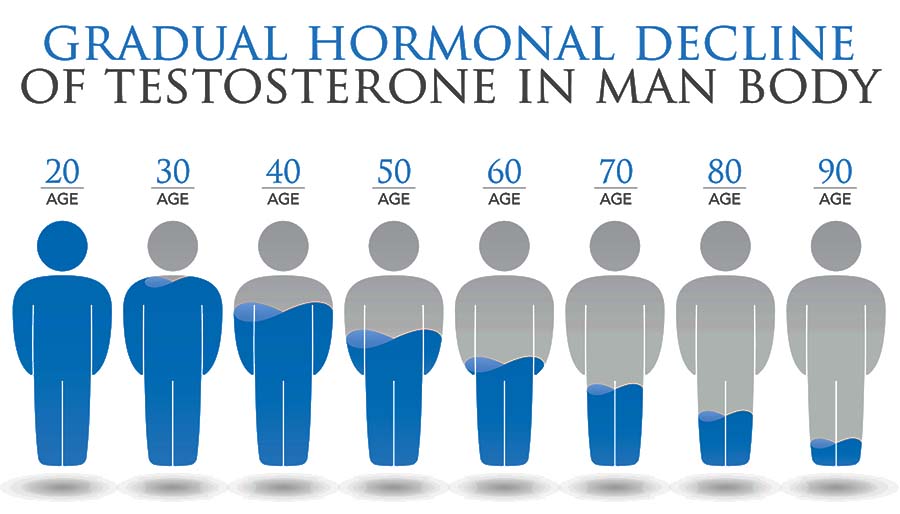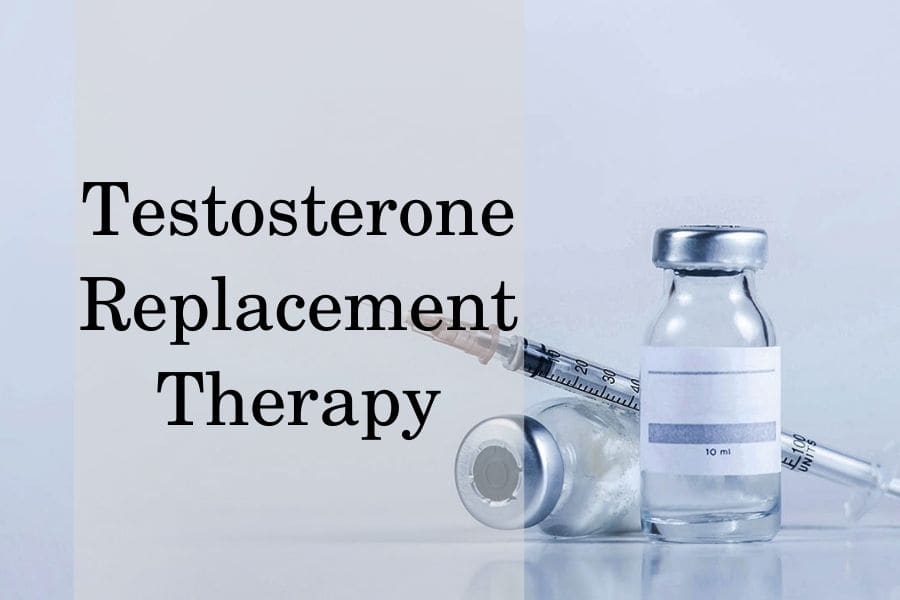Testosterone (T) is the main sex hormone in men and it is produced mainly in the testicles. Testosterone is a potent anabolic steroid with a key role in stimulating masculinity and fertility. The hormone is important for optimal muscle mass, bone mass, erythropoiesis, hair growth, mood, and energy levels.
Unfortunately, the function of the testicles declines with age or might be disrupted due to various health problems.
Its debilitating symptoms affect more than 4 million males in the US, including all ages but especially older men
What does low testosterone do to men?
Low testosterone can lead to a wide range of symptoms in men. The only way to know for sure if that’s the cause of your problems is to visit an experienced medical doctor.
If your testosterone levels are low it may result in a combination of emotional, physical, and sexual changes which can significantly lower the quality of your life.
Scientific evidence suggests that men with low T are more likely to experience depression, mood swings, and lethargy. In addition, men with hypogonadism are more likely to have intellectual problems, difficulty concentrating, and brain fog.
Men with low T often experience physical changes which can have a negative impact on confidence and metabolism. They include losing muscle size and strength while simultaneously gaining extra fat.
One of the biggest concerns amongst men with low T is the related sexual and fertility changes. Affected men may experience a lack of libido, fewer spontaneous erections, and erectile dysfunction.
Besides, endogenous testosterone is necessary for the normal formation of healthy sperm. Low T can lead to reduced spermatogenesis and fertility problems.
Other side effects of low testosterone include low blood cell count (anemia), insulin resistance, and osteoporosis. A trial in middle-aged men also reveals that lower testosterone levels correlate with a worse cholesterol profile.
The combination of obesity, cholesterol problems, anemia, and insulin resistance can increase the risk of chronic and debilitating conditions such as cardiovascular diseases and type 2 diabetes. Scientists report that mortality in men with low testosterone is also significantly elevated compared to healthy individuals.
What causes low testosterone in men?
Low testosterone can be caused by either testicular problems or dysfunction of the hypothalamus and pituitary gland which regulate the testicles.
When the cause of low T production is in the testes, the condition is called primary hypogonadism. The possible causes include genetic syndromes (Noonan and Klinefelter syndrome), anatomical defects, and injuries to the testicles. Factors that can lead to injury include:
- Mechanical trauma
- Infection (Mumps) or autoimmune condition
- Radiation or chemotherapy
- Testicular torsion and infarction
- Testicular tumors and surgery
Furthermore, low T may be caused by late-onset hypogonadism which is the result of the age-related decline in testicular function.
Normally, the hypothalamus and the pituitary gland stimulate the testicles to produce endogenous T. If they do not function properly, it results in testicular atrophy and low testosterone levels. The condition is called secondary hypogonadism and it can be either present since birth (Kalman’s syndrome) or acquired later in life.
Acquired secondary hypogonadism can be caused by:
- pituitary tumors and hyperprolactinemia
- autoimmune inflammation of the pituitary gland or sarcoidosis
- hypothalamic or pituitary damage due to head trauma, infarction, surgery, radiation, etc.
Low T can be caused by certain medications, including glucocorticoids, opioids, and anabolic steroids
For example, studies reveal that long-term therapy with glucocorticoids can suppress both the testicular production of T and the stimulation by the hypothalamus. Prolonged use of opioids is also shown to suppress the hypothalamus and lead to secondary hypogonadism.
Abusing testosterone injections and anabolic steroids can trigger a negative feedback mechanism that suppresses the pituitary gland. It no longer stimulates the endogenous synthesis of T in the testicles leading to their atrophy and secondary hypogonadism.
What are the main symptoms of low T?
The specific symptoms of low T include:
- Fatigue
- Muscle loss
- Depressive mood
- Sexual and erectile dysfunction
- Loss of body hair and reduced beard growth
Depending on the cause of hypogonadism, the symptoms of low testosterone may develop suddenly (e.g., injury) or gradually with time (e.g., aging).
Usually, low T can be the cause of fatigue in men. In addition, it can progress to severe fatigue or even lethargy. The quality of sleep in hypogonadal men might also be negatively affected.
Furthermore, the physical symptoms of low T involve a gradual increase in body fat percentage which is accompanied by losing lean body mass. Patients often experience reduced strength and endurance.
In extremely low levels of T, patients might start losing their facial and body hair
The sexual signs of low T usually start with subtle symptoms such as decreased rate of spontaneous erections and reduced sexual desire. Testosterone controls both the initiation and the end of an erection. Thus its main role is to regulate the erectile function according to your sexual desire and arousal.
When T levels drop down immensely it leads to a complete lack of libido. This results in an inability to initiate or maintain an erection, which makes normal sexual intercourse impossible.
How to diagnose low testosterone
First, you need a diagnosis from a licensed specialist, in order to get a testosterone prescription and legal treatment that will help you manage your symptoms. The diagnosis of low T begins with a visit to the doctor’s office.
It is possible to schedule an online appointment for a telemedicine exam, but most specialists will prefer an in-person visit to better evaluate your health condition. Besides, some specialists suggest that telehealth exams increase the risk of underdiagnosis.
The physician should perform a thorough medical exam, assess your symptoms, and check your past medical history. If you have signs and symptoms that might suggest low testosterone and hypogonadism, your doctor will assign your diagnostic tests.
Despite the convenience of at-home testosterone tests, they are not suitable for diagnosing low testosterone. These tests use saliva instead of blood (serum) to estimate your T levels.
Several factors might lead to bias when measuring testosterone in saliva. Thus, they are not accurate enough to be used as a part of the diagnosis.
Testosterone levels must be measured in serum and the test must be repeated at least once to confirm the diagnosis. Each test must be performed in the morning when the natural testosterone production should be at its peak.
If both of the measurements reveal total testosterone levels below 300 ng/dl and you have symptoms, then your doctor will diagnose you with low T levels and may assign you additional tests to identify the cause of your condition. Once you get a prescription, you can buy testosterone online, making your treatment more convenient and affordable.
How to treat low T in males
Hypogonadism is an endocrinological disorder and as such, it should be treated by a medical specialist in endocrinology.
If you have been diagnosed with low T, your doctor will help you decide the best course of action to manage your symptoms, which might be testosterone replacement therapy.
Testosterone is a medication with significant potential for abuse due to its anabolic effects. It is under strict regulation and you need to get a prescription from your doctor before receiving legal testosterone treatment.
Your doctor should also warn you that low T is a risk factor for heart disease and if left untreated it might lead to cardiovascular complications. Also, you will be more likely to develop anemia and osteoporosis.
Forms of treatment
Testosterone therapy can come in different forms such as gels, patches, implants, pills, and injections.
Testosterone injections are the most preferred form because they are much easier to dose. Furthermore, they lead to a quicker and more reliable increase in serum T levels which helps manage the patient’s symptoms faster.
Thus, injections are the most commonly prescribed form of TRT, especially in patients who are new to the treatment.
Currently, scientists report few medical alternatives to TRT for hypogonadal patients. These include medications that stimulate the pituitary gland to produce more luteinizing hormone (LH) such as clomiphene or mimic LH and stimulate the testicles such as human chorionic gonadotrophin (hCG).
They may be considered in patients with secondary hypogonadism who have preserved testicular function and would like to remain fertile.
What happens when a man takes testosterone?
Testosterone therapy can lead to a wide range of benefits for patients with hypogonadism. A scientific review of more than 40 clinical trials has established the time-course of the benefits, from the time of onset until they reach maximum effectiveness:
- increased libido – 3-6 weeks
- better mood (less depressive symptoms) and quality of life – 3-30 weeks
- improved erectile function – 1-6 months
- improved body composition and cholesterol levels – 1-12 months
- increased red blood cell count and insulin sensitivity – 3-12 months
- higher bone mineral density – 6-36 months
These effects are not permanent and continue only for the duration of the therapy. When TRT is discontinued, the symptoms of hypogonadism are likely to return. Only the increase in bone mineral density tends to persist in the long term.
Possible side effects of TRT may include:
- elevated red blood cell count in combination with a high hematocrit
- prostate enlargement and urination problems
- oily skin and acne
- gynecomastia
- reduced sperm count and infertility
Currently, official guidelines point out that there is no evidence that links testosterone therapy to an increased risk of prostate cancer. Only, patients with a previous history of prostate cancer might be contraindicated for TRT.
There is no conclusive evidence to suggest that testosterone injections might lead to cardiovascular problems.
On the other hand, long-term trials report lower cardiovascular mortality in obese men who take TRT compared to placebo. It is best to combine testosterone therapy with lifestyle changes to improve overall health and minimize risks.
Nevertheless, the doctor should monitor the therapy and regulate the dosage in order to minimize the risk of adverse reactions. Recommendations state that a specialist should evaluate your condition every 3 to 6 months during the first year and then every 6 to 12 months for the following years.
TRT aims to achieve normal testosterone levels in the middle of the optimal reference range. However, the main indicator for the success of the therapy is the effect on the symptoms of hypogonadism.
If TRT is not effective for managing the symptoms or there are other indications against the treatment, you might have to discontinue the treatment. The process of stopping testosterone therapy can lead to side effects and requires strict medical supervision.
Get a free consultation with our medical expert for any questions about hormone replacement therapy





